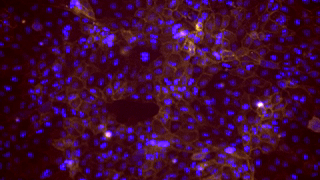
(Left) Bright field time-lapse image input. (Right) Machine learning based predictions of real time, live mesenchymal stromal cell extracellular marker expression from bright field time-lapse input. https://www.nature.com/articles/s41598-021-85905-z

Epithelial crowding is a canonical process of tissue development and remodeling, involving epigenetic alterations induced by intercellular mechanical forces.

We develop quantitative optical imaging methods to investigate soft material properties.

(Left) Bright field time-lapse image input. (Right) Machine learning based predictions of real time, live mesenchymal stromal cell extracellular marker expression from bright field time-lapse input. https://www.nature.com/articles/s41598-021-85905-z
From Developmental Insights to Tissue Engineering
Biological tissues exhibit remarkable regenerative capabilities and essential physiological functions, such as selective barrier and absorption functions, that synthetic systems cannot replicate. The reproducible generation of these living materials is crucial for drug screening, therapeutic development, and organ transplantation. However, engineering biological tissues is complex due to the influence of diverse environmental cues on cellular behavior.
Our lab advances the fundamental understanding of mechanobiology to elucidate disease progression and tissue development, aiming to refine engineering methodologies for lab-grown tissues. We investigate the impact of mechanical cues—including cell-cell adhesion, cell-substrate traction, and cell-flow interaction—on cellular behavior. These mechanical stimuli are nonlinear, dynamic, heterogeneous, and interdependent. To dissect the relationships between these complex signals and cellular responses, we develop instruments to impose specific mechanical signals, label-free microscopy techniques to visualize tissue properties, and comprehensive mechanobiological insights.

From top left: James Lo, Alan Levinson, Dr. Neil Lin, Jerry Chen, Alexandra Bermudez
From bottom left: Kathryn Saxton, Shannon Li, Iris Sloan, Katie Shi
Our work is currently supported by the NSF CMMI AM, NIH NIGMS MIRA, Hellman Fellowship, CNSI Noble Family Innovation Award, JCCC, Eli and Edythe Broad Center of Regenerative Medicine and Stem Cell Research.
Lin Lab Podcast: Behind the Beaker. We are thrilled to share that the first episode of our podcast is now live! Check out this fantastic interview hosted by Zoe, and if you enjoy it, don’t forget to like the video and subscribe to support our series.
